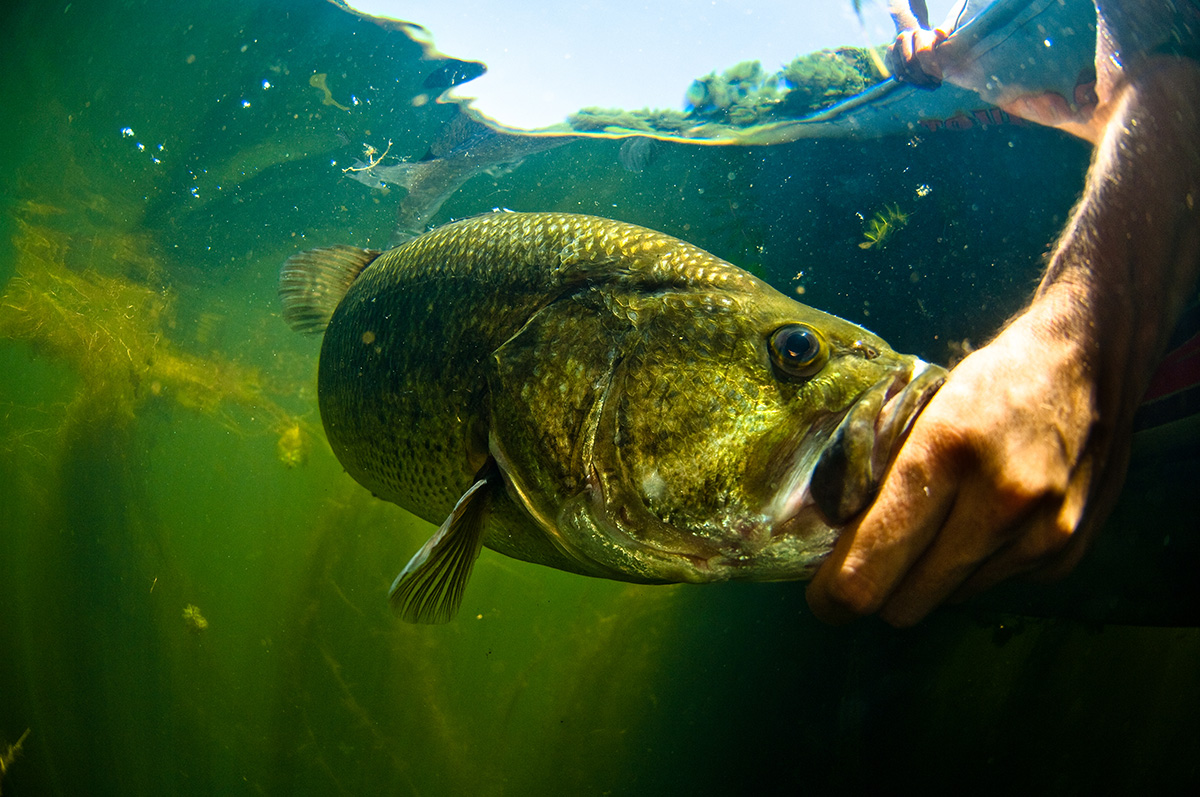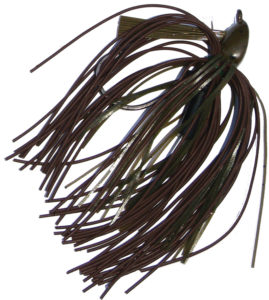
This is no secret amongst my fishing friends that by far, a jig is my favorite bait. It is the one bait that if I could use nothing else, it would be on the end of my line, regardless of the time of year. A jig is a versatile tool that attracts small, medium and large fish. It works in heavy weed cover, stump fields and even in clear, wide open water. With our season in full-swing, let’s take a look at the different scenarios where I employ jigs, and the jigs I find most effective, along with matching trailers.
The Jig
I use three styles of jigs. The first is the most well-known style and is basically the same no matter who makes it. But for argument’s sake, it is similar to the Strike King Rattlin’ Pro or the Structure Jig, followed by the Junkyard and the Mop Jig. All three have relevance, depending on conditions. I use two color schemes – green pumpkin or blue. I remember fishing with Kevin VanDam many years ago, and he commented that early in the year crawfish have a bluish hue to them, and that is why he likes blue. From that point on I began using blue jigs and have caught more 5-plus pounders on them throughout the year than any other color. I do, however, switch back and forth with the greens, during the course of the day.
For covering structure, my choice is usually a 3/8-ounce size matched up to a trailer with the same color scheme. I throw this jig in moderate grass cover, timber and reeds along the banks. The jig has enough weight to get through, but still falls in a subtle way that entices a bite. For trailers on this and the Junkyard I stick with the Berkley Chigger Craw and Yum Craw Papi.
The Junkyard is a unique jig designed to reduce the risk of snags, plus offer incredible hook-ups. The jig is 1/2-ounce and has the widest gap of any jig, but also the shortest shank. It is the optimum jig around wood as it is virtually impossible to hang it up. Speaking of hang-ups, if you are fishing wood, and you believe there is a bass there and get hung up, try the sling-shot method (https://www.youtube.com/watch?v=4jXrCDjx8wk) to free it up. If this fails, lay the rod down and use a second one because if you start jerking and yanking on the jig, any bass that was there will be gone.
The third category is the Mop Jig. This jig is a great one for the times you want a large profile bait. It has longer and heavier strands, weighs in at 3/4 ounce, and is basically the beast of the jigs. I use the mop in heavy grass cover and open water. I also use this jig to swim it through beds in the early part of the season. Add a Big Bite Fightin’ Frog as the trailer and you have a nice fat bait. This jig also excels in the fall when bass are looking to feed and want one large meal, rather than a mess of hors d’oeuvres. This jig is also good when bass are off the feed due to a front or other weather pattern.
The Tackle
Fishing jigs requires a solid outfit. You can leave the light line and spinning gear in the garage for this one. Rods in the 7- to 8-foot class matched to high quality baitcast reels is the way to go. Any of the top-of-the-line reels out there suffices. Shimano, Abu Garcia, Daiwa and Penn are all great options along with many others. I use several different combos. The first consists of an Abu-Garcia Veracity VERC76-6 (rated for 12- to 25-pound test) and an older Daiwa 153HSTA reel spooled with 50-pound braid for the most part. This is the outfit that I use when fishing heavy wood, thick lily pad fields and cattails. The second is the Veracity VERC73-6 (rated for 12- to 20-pound test) with the same reel, but spooled with 30-pound braid and a 10-foot fluorocarbon leader in 20-pound test, tied with a double uni-knot and then finished off with Berkley line glue. In heavier cover, I do not worry about line being seen, but in open water areas, or with less wood and vegetation, I want to make sure there is nothing that hinders the bite. If you use a leader, be sure to check the knot often, and don’t be afraid to retie several times throughout the day. The Veracity has a fast taper making for easy detection of subtle bites, but enough backbone to get them out of cover.
Catch ‘Em Up
We have the baits, we have the rod and reel, now let’s look at how we are going to put fish in the livewell for weighing, or back in the water after a quick photo shoot!
For starters, I do not believe there is any wood or heavy cover that does not hold bass. They may not be there 24/7, but there will always be a bass within close proximity to heavy cover, and in feeding mode at some point during the day. My favorite target is the nastiest looking downed tree I can find. Bass hold right against the bank on wood like this and venture out along the limbs throughout the day. When approaching a blow down, I begin outside on the edges of the limbs, then slowly work towards the interior. Soft entry into the water is paramount. If you drop your bait like a brick, you might as well move on in my opinion. Soft entries will not spook a fish, and remember, the fish you are looking for could be on the edge, or deep against the bank. Work every limb of the tree methodically until you reach the bank. Last but not least, worry about hooking a bass before worrying about how you are going to land him.

My next favorite area is thick lily pad fields. These can be quite intimidating at times due to their sometimes large expanse. An acre of lilies is quite a feat to cover, especially if you are fishing a tournament and on time constraints. Do not get overwhelmed. Look for holes in the pads where a fish may have blown through. Look for cover below the pads like a piece of timber protruding through. Lily pads, for the most part, will be in 2 to 4 feet of water. If the water depth outside the field is deeper, work close to the edge, flipping to holes anywhere from the edge to 10 feet into the pad field. Bass filter back and forth from deep to shallow, and at times hold right on the edge under a lily, in the shade from the sun.
The last two areas are beds and beaver dams. In spring, when fish are on beds, I have found that swimming a Mop jig through the bed or just off the edge very slowly, with a twitch or two, drives a bedding bass crazy. For this, I use a trailer that is either green with some chartreuse or orange in it, which could resemble a bluegill or sunfish.
The key with beaver dams is they are “overfished” on virtually every lake. However, believe it or not, most anglers do not fish them right. Bass will not hold anywhere on a dam, but will hold in certain areas. As you approach a dam, look for the deeper channel the beaver has made to enter his lair. Bass lie just off these channels under the cover of wood or grass. The second area is right at the main entrance to the dam. Find these areas slowly and methodically, and you could come up with a hawg.
To me, duping a bass on a jig is an awesome experience. From the thrill of the hookset, to the skill required to get it to the boat makes it all worth the time and effort to learn the jigging game, and learn it well. Hit the water and give these jigs, trailers and tips a shot. I am sure the reward will outweigh the effort.



